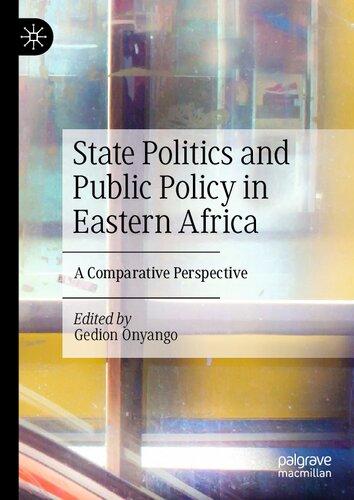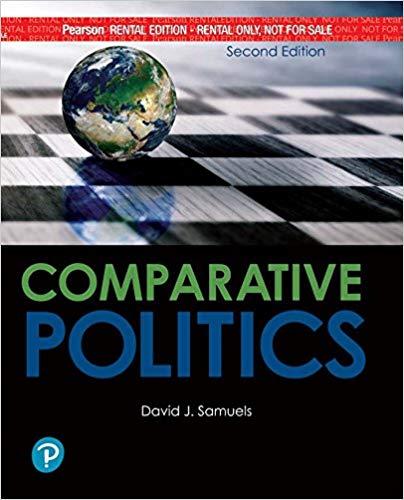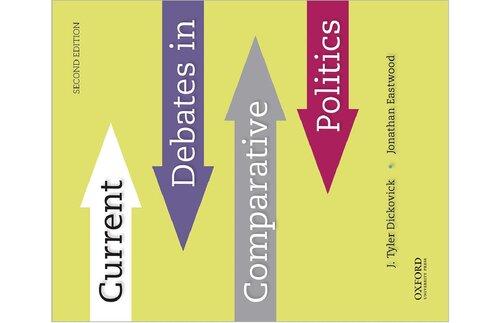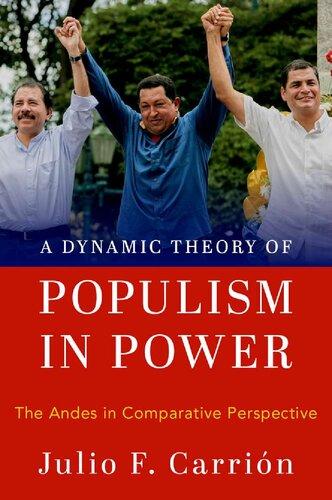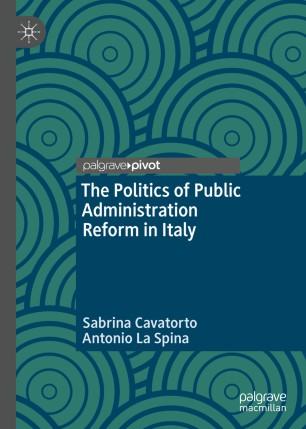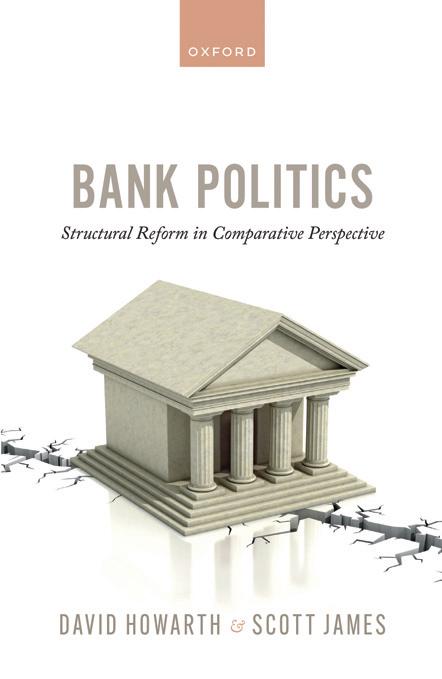Visit to download the full and correct content document: https://ebookmass.com/product/bank-politics-structural-reform-in-comparative-perspe ctive-david-howarth/
More products digital (pdf, epub, mobi) instant download maybe you interests ...
State Politics and Public Policy in Eastern Africa: A Comparative Perspective Gedion Onyango
https://ebookmass.com/product/state-politics-and-public-policyin-eastern-africa-a-comparative-perspective-gedion-onyango/
(eTextbook PDF) for Comparative Politics 2nd Edition by David J. Samuels
https://ebookmass.com/product/etextbook-pdf-for-comparativepolitics-2nd-edition-by-david-j-samuels/
Covering Muslims: American Newspapers in Comparative Perspective Erik Bleich
https://ebookmass.com/product/covering-muslims-americannewspapers-in-comparative-perspective-erik-bleich/
The Reshaping of West European Party Politics: AgendaSetting and Party Competition in Comparative Perspective Christoffer Green-Pedersen
https://ebookmass.com/product/the-reshaping-of-west-europeanparty-politics-agenda-setting-and-party-competition-incomparative-perspective-christoffer-green-pedersen/
Essentials of Comparative Politics (Sixth Edition)
https://ebookmass.com/product/essentials-of-comparative-politicssixth-edition/
Current Debates in Comparative Politics 2nd Edition J Tyler Dickovick
https://ebookmass.com/product/current-debates-in-comparativepolitics-2nd-edition-j-tyler-dickovick/
A Dynamic Theory of Populism in Power: The Andes in Comparative Perspective Julio F. Carrion
https://ebookmass.com/product/a-dynamic-theory-of-populism-inpower-the-andes-in-comparative-perspective-julio-f-carrion/
The Politics of Public Administration Reform in Italy 1st ed. Edition Sabrina Cavatorto
https://ebookmass.com/product/the-politics-of-publicadministration-reform-in-italy-1st-ed-edition-sabrina-cavatorto/
The Geography of Trade Liberalization: Peru’s Free Trade Continuity in Comparative Perspective Omar Awapara
https://ebookmass.com/product/the-geography-of-tradeliberalization-perus-free-trade-continuity-in-comparativeperspective-omar-awapara/
BankPolitics BankPolitics StructuralReforminComparative Perspective DAVIDHOWARTH SCOTTJAMES GreatClarendonStreet,Oxford,OX26DP, UnitedKingdom
OxfordUniversityPressisadepartmentoftheUniversityofOxford. ItfurtherstheUniversity’sobjectiveofexcellenceinresearch,scholarship, andeducationbypublishingworldwide.Oxfordisaregisteredtrademarkof OxfordUniversityPressintheUKandincertainothercountries ©DavidHowarthandScottJames2023
Themoralrightsoftheauthorshavebeenasserted Impression:1
Allrightsreserved.Nopartofthispublicationmaybereproduced,storedin aretrievalsystem,ortransmitted,inanyformorbyanymeans,withoutthe priorpermissioninwritingofOxfordUniversityPress,orasexpresslypermitted bylaw,bylicenceorundertermsagreedwiththeappropriatereprographics rightsorganization.Enquiriesconcerningreproductionoutsidethescopeofthe aboveshouldbesenttotheRightsDepartment,OxfordUniversityPress,atthe addressabove
Youmustnotcirculatethisworkinanyotherform andyoumustimposethissameconditiononanyacquirer
PublishedintheUnitedStatesofAmericabyOxfordUniversityPress 198MadisonAvenue,NewYork,NY10016,UnitedStatesofAmerica
BritishLibraryCataloguinginPublicationData Dataavailable
LibraryofCongressControlNumber:2022942794
ISBN978–0–19–289860–9
DOI:10.1093/oso/9780192898609.001.0001
Printedandboundby CPIGroup(UK)Ltd,Croydon,CR04YY
LinkstothirdpartywebsitesareprovidedbyOxfordingoodfaithand forinformationonly.Oxforddisclaimsanyresponsibilityforthematerials containedinanythirdpartywebsitereferencedinthiswork.
Preface Aswewrite,itisoverthirteenyearssincethecollapseofLehmanBrothers,the fourthlargestinvestmentbankintheUnitedStates.Theinternationalfinancial systemisbeginningtore-emergefromanotherboutofinstability,thistimetriggeredbytheeconomicshutdownnecessitatedbytheCovid-19pandemic.Thefact thatthebankingsystemsinadvancedeconomiesappeartohaveemergedinsignificantlybettershapethantheydidfollowingthecollapseoftheUnitedStates (US)sub-primemortgagemarketin2007isarguablytestamenttotheeffectivenessoftheraftofnewregulationimposedonthebankingsectoroverthepast decade.Thesenewruleshavetakenavarietyofforms,fromhighercapitaland liquidityrequirements,andnewrulesonbankrecoveryandresolution,through tobonuscaps,banklevies,andstrengthenedcriminalsanctions.Theauthorsofa numberofthesenewregulationsclaimedtohaveaddressedoneofthefundamentalchallengesposedbythe2008crisis:thefactthatthelargestbankshadbecome ‘too-big-to-fail’(TBTF)—shorthandfortheargumentthatsomebankshadsimply becomesosystemicallyimportantthatnogovernmentcouldeverpermitthemto fail.Ascriticspointedout,thismeantthatTBTFbanksposedathreattofinancialstabilitybyincentivizinggreaterrisk-takingandspeculativeactivity,enjoyed animplicitstatesubsidyintheformoflowerexternalfundingcosts,andwould imposeanintolerableburdenontaxpayersthroughtheguaranteeofabail-outin theeventoffailure.
Aspoliticaleconomistswithalongstandinginterestinthepowerandpolitics ofbanking,andthepoliticaleconomyoffinancialregulationmorebroadly,we weredrawninexorablytothetopicofTBTFbanks.Ourcuriositywaspiquedby thefactthatoneofthemostimportantregulatoryinnovationsdesignedtoaddress directlytheissueofTBTF—namely,bankstructuralreform—provedtobeoneof themostdivisive.Structuralreformreferstofinancialregulationsthatrestrictthe abilityofretailbankstoengageinhigher-riskspeculativetradingand‘marketmaking’,eitherthroughstatutorybansorthestructuralseparationoftheseactivities fromdeposittaking.Wewereparticularlyfascinatedbytheextentofdivergence betweendifferentcountrieswithregardtothestringency,scope,andbreadthof thesereforms.Thisdivergencestoodinstarkcontrasttothetrendtowardsgreater financialregulatorycoordinationandharmonization,throughthedevelopment ofcommonEuropeanUnion(EU)rulesorglobalstandards,thatcharacterizes mostotherareasofpost-crisisbankingregulation.Theempiricalrecordtherefore presenteduswithanintellectualpuzzlethatwassimplytootemptingtoignore.
Wewerethereforesomewhatsurprisedtodiscoverthatscholarshiponbank structuralreformsincetheglobalfinancialcrisisisratherlimited.Despitethe existenceofseveralsinglecaseandsmallcomparativestudiesonthesubject,we believedthatamorein-depth,book-lengthcomparativeanalysisofthetopicwas urgentlyneeded.Ourmotivationwastoseeifthecomparativemethodcouldshed importantnewlightonthesurprisingvariationinregulatoryoutcomes—from stringentreformthroughtonoreformatall—onbankstructuralreforminmajor economies.ThisvariationwasallthemorepuzzlinggiventhatmanyofthecountriesthatinterestedusinEuropeandNorthAmericawerehosttonumerousTBTF banksthathadsufferedlargelossesafter2007,necessitatinghugegovernment bail-outsandfanningtheflamesofpublicangertowardsthebankingindustry. Wewerealsokeentounderstandthestarklydivergentoutcomesoftheworld’s twolargestfinancialjurisdictions—theUSandtheEU—whichappearedtoconfoundwidelyheldperceptionsabouttheirrespectiveproclivityfortoughfinancial rules.
Inwritingthisbookwehavedrawnonresearchundertakenforanumberof journalarticlesthatwehavepublishedinrecentyears.Indeed,whatsparkedour initialinterestinthistopicwastheimmenselyrewardingexperienceofediting (withHuwMacartney)aspecialissueinthejournalBusinessandPoliticson‘Bank PowerandPublicPolicysincetheFinancialCrisis’,publishedinJanuary2020(Vol. 22,SI.1).Furthermore,thearticlethatwewroteforthisspecialissue(seeHowarth andJames2020)providedavaluabletestinggroundfortheearlytheoreticaldevelopmentandempiricalanalysisthatwedevelopandextendinthebook. Chapter5 alsodrawsonresearchconductedforJames(2018).Theauthorsacknowledgethe generousfinancialsupportoftheEconomicandSocialResearchCouncil,which helpedtofundpartoftheearlyresearchonthechapterontheUnitedKingdom (UK)(grantreferenceES/K001019/1),andtheLuxembourgFondsNationalde laRecherche,whichfundedpartoftheresearchontheEU,FrenchandGerman chapters(grantreferenceC19/IS/13712846).
Almostcertainlyourbookwouldneverhavebeenwrittenwithouttheimmeasurablehelp,support,andadviceoffellowscholars.Wewouldliketothankarange ofacademiccolleaguesfortheirhelpfulfeedbackonouranalyticalapproachand theempiricaldetailsofourcasestudies.Theauthorstestedtheiranalyticalframeworkatanumberofacademicconferencesandwitharangeoffinancialsector actorsinLondon,Luxembourg,andelsewhere.Theintellectualjourneyforthe bookbeganwiththeorganizationofaworkshopbyDavidHowarthandHuw Macartneyon‘ThePoliticsandPoliticalEconomyofBankReform:TenYears aftertheFinancialCrisis’forthe46thEuropeanConsortiumofPoliticalResearch (ECPR)JointSessionsofWorkshopsattheUniversityofNicosia,Cyprus,inApril 2018.Thelivelydiscussionandconstructivefeedbackthatthisworkshopfostered subsequentlyformedthebasisforthe BusinessandPolitics specialissuementionedabove.Arevisedversionofourcomparativepaperwasalsopresentedat
theECPRGeneralConferenceattheUniversityofHamburginAugust2018and attheLuxembourgMonthlyFinanceLunchorganizedbytheInstituteforGlobal FinancialIntegrityinJune2018.Themainargumentsmadeinthisbookwerelater presentedataLeidenUniversitysummerschoolinJune2021,ataresearchseminarattheSheffieldPoliticalEconomyResearchInstitute,UniversityofSheffield, inSeptember2021,attheEuropeanConsortiumofPoliticalResearchStanding GroupontheEUbiennialconference,LuissUniversity,Rome,andattheCouncil forEuropeanStudiesbiennialconference,UniversityInstituteofLisbon,bothin June2022.
Althoughtheparticipantsatthenumerousconferencesandworkshopsatwhich earlieriterationsofourresearchwerepresentedaretoonumeroustomention,we wouldliketosingleoutthefollowingforspecialthanksforstimulatingdiscussions, productiveexchanges,andcollaborationovermanyyears:HuwMacartney,Lucia Quaglia,AnetaSpendzharova,ManuelaMoschella,ElsaMassoc,JosephGanderson,JasperBlom,ShawnDonnelly,IainHardie,ClémentFontan,DoraPiroska, StefanoPagliari,andKevinYoung.Wealsowishtothanktheanonymousreviewersforthefeedbackandcommentsonourinitialbookproposal,aswellasthefifty policymakers,financialregulators,andfinancialindustrypractitionersthatselflesslygaveuptheirtimesothatwecouldinterviewthemforourbook.Finally,we areimmenselygratefultotheserieseditoratOxfordUniversityPress,Dominic Byatt,forhispromptinterestinandunstintingcommitmenttoourproject.
ScottJamesisindebtedtotheDepartmentofPoliticalEconomyatKing’s CollegeLondonforprovidingathrivingintellectualspaceandwelcomingenvironmentwithinwhichthebookcoulddevelop.ScottisalsogratefultotheSheffield PoliticalEconomyResearchInstituteattheUniversityofSheffieldwherehewas basedasavisitingresearcherbetweenJulyandDecember2021.Theinstituteprovidedawonderfulacademic‘secondhome’forcompletingthebook—assuch, specialthanksmustgotoColinHayandTomHuntformakingthispossible,and toAndrewHindmoor,SimonBulmer,andScottLaveryfortheirincisivecommentsandfeedback.DavidHowarthwouldliketoextendhisthankstheInstitute ofPoliticalScienceattheUniversityofLuxembourgforitsgenerousfinancial assistance,whichmadepossibleseveraltripstoconductinterviewsandgraduate studentresearchandeditorialassistance.DavidisalsogratefultotheDepartment ofPoliticalScienceatLeidenUniversitywherehewasavisitingprofessorbetween MarchandJuly2021.
Ourbookalsobenefitedgreatlyfromtheworkoffivegraduatestudent helpers.MargotBouchez,aUniversityofLuxembourgMaster’sstudent,andSean Domberg,aformerMaster’sstudentattheUniversityofMaastricht,located andtranslatedDutch-languagematerial.MoritzRehm,adoctoralstudentatthe UniversityofLuxembourg,locatedandtranslatedGerman-languagematerial. SébastianCommain,alsoadoctoralstudentattheUniversityofLuxembourg, undertookanumberofinterviewsinBrusselsandParis.MiaDzepina,another
UniversityofLuxembourgMaster’sstudent,assistedwithproofreadingthetext andthepreparationofreferences.HarpalHungin,aformerPh.D.studentatthe EuropeanUniversityInstituteandco-authorwithScottJames,wasalsoagreat sourceofassistanceonregulatorydevelopmentsintheUS,andweareindebted tohimforgrantinguspermissiontoquoteseveralinterviewsthatheconducted withUSpolicymakersaspartofhisdoctoralthesis.
Lastly,butsurelynotleast,wealsothankourfamiliesandfriendsfortheir unwaveringsupportandpatienceoverthepastfewyears.
DavidHowarth
LuxembourgandLondon August2022
ScottJames
ListofTables
1.Introduction:ThePuzzleofBankStructuralReform
4.FromObamatoTrump:ContestedReformintheUnited States
5.TheImportanceofBeingVickers:VenueShiftinginthe UnitedKingdom
6.Germany:DefendingDeutscheBankAG
7.France:DefendingtheNationalChampions
8.TheNetherlands:ShiftingStructuralReformOffthe
9.Liikanen’sLegacy:FinancialPowerandPoliticalStalemate intheEuropeanUnion
1.1.OverviewofadoptedbankstructuralreformsintheUK,US,France,and Germany 4
1.2.BankFundingGap,casestudycountries,percent,2000–7
1.3.Largestuniversalbanks,totalassetsandasapercentageofnationalGDP (casestudycountries;totalassets,nationalcurrency,billions),end2000, 2007,2011,2014
1.4.BankingsystemassetsasapercentageofGDP,2002–16 13
1.5.Bankingsystemassetsasapercentageoftotalfinancialinstitutionassets(case studycountries),2002–16 13
1.6.Bankingsystemconcentration(percentageoftotalassetsheldbylargest three/fivebanks),2002–16 14
1.7.Numberofsystemicallyimportantbanksbycountryatend2018 14
2.1.Outcomesofbankstructuralreform 61
3.1.Nationalrescues/protectionofTBTFbanks,2007–10 71
3.2.Revenue-raisingmeasurestodiminishbankriskandcoverbail-outcosts
3.4.Banktier-1capitalratio(asapercentageofrisk-weightedassets,recallBasel IIItargetof6%withatleast4.5%ofRWA;10.5–13%withbuffers;casestudy countries),2008–18 86
3.5.Bankleverage:simpletier-1unweightedcapitalratio(recallBaselIIItarget ofatleast3%;casestudycountries),2008–16 87
3.6.Bankliquidassetsasapercentageoftotalassets(casestudycountries), 2002–16 93
3.7.Shareofdepositsintotalfunding(asapercentageoftotalfunding;casestudy countries),2002–16 94
3.8.Shareofborrowingintotalbankfunding(asapercentageoftotalfunding; casestudycountries),2006–16 94
3.9.Bankfinancialliabilitiesheldfortradingasapercentageoftotalassets (France,Germany,andtheNetherlands),2008–18 95
3.10.BankgovernancemeasurestodiminishTBTFbankrisk
3.11.ReinforcedsupervisiontodiminishTBTFbankrisk 103
ListofAbbreviations ABA AmericanBankingAssociation
ABCP Asset-BackedCommercialPaper
ABI AssociationofBritishInsurers;ItalianBankingAssociation
ABNAMRO AlgemeneBankNederland-AmsterdamRotterdamBank
ABS AssetBackedSecurities
ADAM AssociationfortheDefenceofSmallShareholders(Associationdedéfense despetitsactionnaires)
AFEP FrenchAssociationofPrivateEnterprises(Associationfrançaisedes entreprisesprivées)
AFG FrenchSocietyofFinancialAnalysts(Associationfrançaisedelagestion financière)
AFME AssociationforFinancialMarketsinEurope
AFR AmericansforFinancialReform
ALDE AllianceofLiberalsandDemocratsforEurope
AMF FinancialMarketsAuthority(Netherlands)(AutoriteitFinanciële Markten)/FinancialMarketsAuthority(France)(Autoritédesmarches financiers)
ANP NetherlandsNewsAgency(AlgemeenNederlandsPersbureau)
ATTAC Anti-capitalism/anti-globalizationmovement
BaFin GermanFederalFinancialSupervisoryAuthority(Bundesanstaltfu¨r Finanzdienstleistungsaufsicht)
BBA BritishBankers’Association
BBVA BancoBilbaoVizcayaArgentaria
BCBS BaselCommitteeonBankingSupervision
BCC BritishChambersofCommerce
BCCI BankofCreditandCommerceInternational
BDA ConfederationofGermanEmployers’Associations(Bundesvereinigung derDeutschenArbeitgeberverba¨nde)
BDB GermanBankingAssociation(BundesverbanddeutscherBanken)
BDI FederationofGermanIndustries(BundesverbandderDeutschen Industrie)
BEUC EuropeanConsumerOrganization
BFI BureauofFinancialInstitutions
BIS BankforInternationalSettlements
BRRD BankRecoveryandResolutionDirective
BNP BanqueNationaledeParis
BPCE BanquesPopulaires,Caissesd’Epargne
BVR FederalAssociationofGermanCooperativeBanks(Bundesverbandder DeutschenVolksbankenundRaiffeisenbanken)
CBI ConfederationofBritishIndustry
CCAR ComprehensiveCapitalAnalysisandReview
CCPs Centralcounterparties
CCSF FinancialSectorAdvisoryCommittee(Comitéconsultatifdusecteur financier)
CDA DutchChristianDemocraticParty
CDU GermanChristianDemocraticUnion
CEBS CommitteeofEuropeanBankingSupervisors
CEOs Chiefexecutiveofficers
CET CommonEquityTier
CFPB ConsumerFinancialProtectionBureau
CFTC CommodityFuturesTradingCommission
CGT GeneralConfederationofLabour(ConfédérationGénéraleduTravail)
CMOC CommodityMarketsOversightCoalition
COREFRIS CouncilofFinancialRegulationandSystemicRisk(Conseilderégulation financièreetdurisquesystémique)
CPE Comparativepoliticaleconomy
CRAs Creditratingagencies
CRDs CapitalRequirementsDirectives
CRR CapitalRequirementsRegulation
CSU ChristianSocialUnion
CU DutchChristianUnion
D66 DutchLiberalDemocrats
DFAST Dodd–FrankActstresstests
DGB GermanFederationofTradeUnions(DeutscherGewerkschaftsbund)
DGS DepositGuaranteeScheme
DIF DepositInsuranceFund
DIHK GermanChamberofCommerceandIndustry(DeutscherIndustrieund Handelskammertag)
DK GermanBankingIndustryCommittee(DeutscheKreditwirtschaft)
DNB Dutchcentralbank(DeNederlandscheBank)
DSGV GermanSavingsBanksandGiroAssociation(DeutscherSparkassenund Giroverband)
EACB EuropeanAssociationofCooperativeBanks
EAPB EuropeanAssociationofPublicBanks
EBA EuropeanBankingAuthority
EBRD EuropeanBankforReconstructionandDevelopment
EBF EuropeanBankingFederation
ECB EuropeanCentralBank
ECOFIN CouncilofEconomicandFinanceMinisters
EEA EuropeanEconomicArea
EELV EuropeÉcologieLesVerts(FrenchGreenParty)
EFA EuropeanFreeAlliance
EFR EuropeanFinancialServicesRoundTable
EMU EconomicandMonetaryUnion
ENA NationalAdministrationSchool(EcoleNationaled’Administration,France)
EPP EuropeanPeople’sParty
ESA(s) EuropeanSupervisoryAgency(ies)
ESBG EuropeanSavingsBanksGroup
ESM EuropeanStabilityMechanism
ESRB EuropeanSystemicRiskBoard
EU EuropeanUnion
FBC FutureofBankingCommission
FBF FrenchBankingFederation(Fédérationbancairefrançaise)
FCA FinancialConductAuthority
FDIC FederalDepositInsuranceCorporation
FDP FreeDemocraticParty
FHFA FederalHousingFinanceAgency
FO ForceOuvrière(FrenchTradeUnion)
FPC FinancialPolicyCommittee
FSA FinancialServicesAuthority
FSB FederationofSmallBusinesses;FinancialStabilityBoard
FSF FinancialStabilityForum
FSOC FinancialStabilityOversightCouncil
FSR FinancialServicesRoundtable
FTT FinancialTransactionsTax
G7 GroupofSeven
G20 GroupofTwenty
GAO GovernmentAccountabilityOffice
GDP Grossdomesticproduct
G-SIBs Globalsystemicallyimportantbanks
G-SIFIs Globalsystemicallyimportantfinancialinstitutions
HBOS HalifaxBankofScotland
HQLAs High-qualityliquidassets
HRE HypoRealEstate
ICB IndependentCommissiononBanking
ICBA IndependentCommunityBankersofAmerica
ICFR InternationalCentreforFinancialRegulation
IDIs Insureddepositoryinstitutions
IFLR InternationalFinancialLawReview
IIF InternationalInstituteofFinance
IMF InternationalMonetaryFund
ING InternationalNederlandenGroep
IPE Internationalpoliticaleconomy
IRSG InternationalRegulatoryStrategyGroup
ISDA InternationalSwapsandDerivativesAssociation
LAC LossAbsorbingCapacity
LCR LiquidityCoverageRatio
Libor Londoninterbankofferedrate
LTO DutchFederationofAgricultureandHorticulture(Land-enTuinbouworganisatie)
MEDEF Frenchemployers’association(MouvementdesentreprisesdeFrance)
MEP MemberoftheEuropeanParliament
MKB DutchFederationofSmallandMedium-SizedEnterprises(Midden-en kleinbedrijf)
MREL Minimumrequirementsforeligibleliabilities
NCUA NationalCreditUnionAdministration
NGOs Non-governmentalorganizations
NSFR NetStableFundingRatio
NVB DutchBankingAssociation(NederlandseVerenigingvanBanken)
OBR OfficeforBudgetResponsibility
OCC OfficeoftheComptrolleroftheCurrency
OFR OfficeofFinancialResearch
OFT OfficeofFairTrading
OLA OrderlyLiquidationAuthority
OTCDs Over-the-counterderivatives
OTS OfficeofThriftSupervision
PACs PoliticalActionCommittees
PCBS ParliamentaryCommissiononBankingStandards
PCGD PostchequeandGiroService
PIRG PublicInterestResearchGroup
PRA PrudentialRegulatoryAuthority
PRC PrudentialRegulationCommittee
PRG Partiradicaldegauche(Frenchcentre-leftparty)
PvdA DutchLabourParty
PVV DutchPartyforFreedom
PwC PricewaterhouseCoopers
RBS RoyalBankofScotland
RCO CouncilofCentralBusinessOrganization
RPS Rijkspostspaarbank
RWAs Risk-weightedassets
SEC SecuritiesandExchangeCommission
SER SocialandEconomicCouncil
SIFIs Systematicallyimportantfinancialinstitutions
SIFMA SecuritiesIndustryandFinancialMarketsAssociation
SMEs Smallandmedium-sizedenterprises
SNS SamenwerkendeNederlandseSpaarbanken(Co-operatingDutchSavings Banks)
SOMO StichtingOnderzoekMultinationaleOndernemingen(DutchFoundation forResearchonMultinationalEnterprises)
SP DutchSocialistParty
SPD GermanSocialDemocraticParty
SPOE SinglePointofEntry
SRF SingleResolutionFund
SRM SingleResolutionMechanism
SRMR SingleResolutionMechanismRegulation
SSM SingleSupervisoryMechanism
TARP TroubledAssetReliefProgram
TBTF Too-big-to-fail
UK UnitedKingdom
UKFI UKFinancialInvestments
UMP Unionpourunmouvementpopulaire(Frenchcentre-rightparty)
US UnitedStates
VNO-NCW ConfederationofDutchIndustryandEmployers(VerbondvanNederlandseOndernemingen(VNO)–NederlandsChristelijkWerkgeversverbond(NCW))
VÖB FederalAssociationofGermanPublicSectorBanks(Bundesverband ÖffentlicherBankenDeutschland)
VoC VarietiesofCapitalism
VoFC VarietiesofFinancialCapitalism
VVD People’sPartyforFreedomandDemocracy
WEED WorldEconomy,EcologyandDevelopment
WRR ScientificCouncilforGovernmentPolicy(WetenschappelijkeRaadvoor hetRegeringsbeleid)
WSBI WorldSavingsBanksInstitute
ZDH GermanConfederationofSkilledCrafts(ZentralverbanddesDeutschen Handwerks)
ZKA CentralCreditCommittee(ZentralerKreditausshuss)
Introduction ThePuzzleofBankStructuralReform 1. Frombail-outstobankingreform Theinternationalfinancialcrisisthatbeganin2007imposedanunprecedented burdenontaxpayers.ItisestimatedthatbailingoutthebankingsectorcollectivelycostEUmemberstategovernments€1.6tn(EUParliament2013,p.4),while theUSgovernmentfacedabillfor$426.4bn.Inresponsetomountingpublic angerandpoliticalpressureforreform,governmentsimposedavarietyofnew regulatoryinstrumentsdesignedtostrengthenthestabilityofbankingandwider financialsystems:fromhighercapitalrequirementsandnewrulesonbankresolution,tostrengthenedcriminalsanctionsandbankingstandards.Yetthemost persistentissue,andarguablythemostdifficulttosolve,hasbeenhowtoaddress theproblemoftoo-big-to-fail(TBTF):shorthandforthenotionthatsomebanks aresimplysosignificantineconomictermsthatnogovernmentcouldeverpermitthemtofail.This,itisfrequentlyargued,ineffectamountstoanimplicitstate subsidyandexacerbatesrisk-takingbehaviourthroughthecreationofmoralhazard(AlessandriandHaldane2009; Haldane2012; HardieandHowarth2013a; BellandHindmor2015a).Theneedtoprotecttaxpayersfromfuturebail-outs byrestrictingtheabilityofretailbankstoengageinhigher-risktradingactivities wasamajorthemeofthe2009G20PittsburghSummit(G202009).Yetefforts todevelopacoordinatedapproachattheinternationallevelhavebeenlimited, withtheresultthatcountrieshavepursuedtheirowndistinctreformtrajectories (Spendzharova2016).Thecentralaimofthisbookistounderstandwhysixjurisdictionswithbankingsystemsthatareamongtheworld’slargestpursuedsuch divergentapproachestobankingreform.
Thebookaddressesthispuzzlebyanalysingthepoliticsofbankstructural reformintheUS,EU,andfourEuropeancountrieswithlargeeconomiesand bankingsystems:theUK,France,Germany,andtheNetherlands.Inthedecades priortothefinancialcrisis,thebankingsystemsofallsixjurisdictionsshareda numberofimportantfeatures(HardieandHowarth2013a).Allthecasesweexaminehadseenthegrowthoflarge,universalbanks.InthecaseofEurope,these bankswereeitherexplicitlyorimplicitlysupportedbygovernmentsandregulators asnationalchampions.IntheUK,France,andtheNetherlands,theselargebanks alsodominatedlendingtotherealeconomy.Moreimportantly,thelargeuniversal
banksinallsixjurisdictionsengagedin‘market-basedbanking’,characterizedby therapidexpansionoftradingassetsonbankbalancesheetsandincreaseddependenceofbanksonshort-termwholesalefinancialmarketstofundlending(Hardie andHowarth2013a).Thesecommontrendsbroughtrisks,however.Whilehugely profitable,market-basedbankingbroughtgreatervulnerabilityandweaknessto disruptioninfinancialmarkets,meaningthatrelativelysmalllosseswereamplifiedbythebanks’largetradingbooks(BellandHindmoor2015a,p.9).Asaresult, allfiveofourcasestudycountrybankingsystemswerehithardbythefinancial crisis—significantlyintheUS,theUK,theNetherlands,andGermany,albeitless inFrance—resultinginplummetingsharepricesandcreditratingdowngrades forthelargestbanks,anddebtwrite-downsforseveral.Moreover,governments wereforcedtorescuetheirbanksbyprovidingunprecedentedstatesupportinthe formofliquidityinjections,governmentbail-outs,andcreditguarantees(Woll 2014).
Intheyearsthatfollowed,politiciansinallsixjurisdictionscameunderpolitical pressuretodealwiththeperceptionthatbankshadbecomeTBTF.Inparticular,attentionfocusedonexcessiverisk-takingandspeculativeactivitieswithin largebanks,andhowtoeliminatetheimplicitsubsidytheyenjoyedfromtaxpayers.Theimpetusforstructuralreformfrequentlycamefromelectoraldynamics: includingtheUSpresidentialelectionin2008andmid-termelectionsin2010, andnationallegislativeelectionsintheUKin2010,Francein2012(legislative andpresidential),theNetherlandsin2010and2012,andGermanyin2013.These dynamicsledprominentpoliticalfigurestomakeearlycommitmentstopursue bankstructuralreform:intheUS,PresidentObamamadethesurprisedecisiontosupporttoughnewrestrictionsonbanks’speculativeactivitiesaspart ofhisadministration’sflagshipfinancialreformbill;intheUK,PrimeMinister CameronestablishedanIndependentCommissiononBanking(ICB)tomakerecommendationsonbankingreform,underpressurefromhiscoalitiongovernment partners;inFrance,PresidentHollandewaselectedin2012followingacampaign thatincludedapledgetoimplementafullsplitbetweenretailandinvestment banks;inGermany,ChancellorMerkelrespondedtopressurefromtheopposition SocialDemocraticPartyfortoughnewbank‘ringfencing’rulesbyencouraging hergovernmenttodevelopitsownproposals;andintheNetherlands,Finance MinisterWouterBosspokepositivelyabouttheneedfornewrestrictionson proprietarytradingattheheightofthecrisis.Inparalleltothesedevelopments, theEUInternalMarketCommissioner,MichelBarnier,announcedthecreation ofaHigh-LevelExpertGroupin2011toconsiderEUregulationonstructural reform.
Despitethesesimilarities,theoutcomeofreforminoursixcasesdifferssubstantially.IntheUS,theObamaadministrationsucceededinmobilizingsufficient politicalsupportinCongresstosecurelegislativeapprovalforabanonproprietarytrading(the‘VolckerRule’).Likewise,intheUK,theConservative–Liberal
Democratcoalitiongovernmentmovedquicklytoendorsetherecommendations oftheVickersCommissionwhichsetoutto‘ringfence’banks’retailactivitiesin legallyseparateentities,prohibitingthemfromtradinginarangeoffinancial instrumentsandsubjecttomuchhighercapitalrequirements.Incontrast,the Frenchgovernmentsoonbacktrackedonitsearliercommitmenttostructural reform,whiletheGermangovernmentnevershowedmuchenthusiasm.Asa result,bothgovernmentsimplementedmuchweakermeasuresrequiringbanksto ringfenceonlyanarrowsetofproprietarytradingactivities,whichdidnotsignificantlyconstraintheirlargestbanks(HardieandMacartney2016; Spendzharova 2016; Massoc2020).IntheNetherlands,earlysupportforstructuralreform— fromthefinanceministerandleft-wingoppositionparties—waschallengedby theconclusionsofthreeseparatecommissions.Asaresult,thegovernmentopted tofocusitsreformeffortsonenhancingbanksupervisionandcurbingbanker behaviourthroughbonuscapsandcodesofconduct.Finally,inaneffortto fosterthegreatercoordinationofbankingreformacrossEurope,theEUCommissiondevelopeditsownringfencingproposals,basedontherecommendations oftheexpertgroupchairedbytheGovernoroftheBankofFinland,ErkkiLiikanen.YetdespiteCommissionconsultationsattractingover500responses,and majordebatesintheEuropeanParliament,structuralreformstalledduetooppositionintheParliamenttotheweakversionofreformacceptedbymember stategovernments,andthedraftlegislationwasfinallyabandonedinOctober 2017.
Thestartingpointofouranalysisisthatinallsixjurisdictions,theissueofTBTF bankingbecameasalientpoliticalissuefrom2008,generatingsignificantpolitical pressureonpolicymakers—fromlegislators,oppositionparties,financialregulators,civilsociety,and/orvoters—tointroducereformstobankstructure.The puzzlewesetouttoaddressiswhytherewassuchwidedivergenceinregulatory outcomesintheUSandEurope,assummarizedinTable 1.1.Inotherwords: Why didsomejurisdictionspursuesignificantbankstructuralreformsafterthefinancial crisis,whileotherjurisdictionsintroducedonlyminimalornoreformatall?
2. Thelimitsofexistingscholarship Therearestrongempiricalandtheoreticalgroundsforwritingabookonbank structuralreform.Theglobalfinancialcrisisspawnedavastacademicliterature onthetransformationoffinancialgovernanceandfinancialregulation.Muchof thishasbeendevotedtoanalysingandexplainingtheraftofnewinternational standardsandEU-levelrulesintroducedoverthepastdecade(forexample,see Lall2012; Young2012; Baker2013a, 2013b; Rixen2013, 2015; Helleiner2014; Mu¨gge2014; PagliariandYoung2014; Quaglia2014a, 2014b; Goldbach2015a, 2015b; Knaack2015; Mu¨ggeandStellinga2015; Tsingou2015; Ban,Seabrooke,
Table1.1 OverviewofadoptedbankstructuralreformsintheUK,US,France,andGermany
Structural separation
TheUKFinancial Services(Banking Reform)Actstipulates thatUKbanks’retail activities—definedas deposits,smallbusinesslending,and paymentsystems— shouldbeplacedina ringfencedsubsidiary. Thesearenolonger permittedtoengagein thetradingofderivativesandsecurities, provideservicesto otherfinancialcompanies,orservices tocustomersoutside theEuropeanEconomicArea(EEA). Theringfencedentity shouldalsohaveindependentgovernance andbelegallyseparateandoperationally separable.
The‘VolckerRule’refersto section619oftheDodd–FrankWallStreetReform andConsumerProtection Act.Theruleprohibits banksfromusingtheir ownaccountsforshorttermproprietarytrading ofsecurities,derivatives, andcommodityfutures, aswellasoptionsonany oftheseinstruments,with exemptionsforhedging purposes(i.e.,interest rateandforeigncurrency swaps).Therulealsobars banks,orinsureddepositoryinstitutions,from acquiringorretainingownershipinterestsinhedge fundsorprivateequity funds,beyonda deminimis exemption(upto 3%ofCommonEquity Tier(CET)1capital/3% ownershipoffundcapital).
Frenchlaw(LawontheSeparationandRegulationofBanking Activities—laloideséparationet derégulationdesactivitésbancaires,2013)requiresFrench banksandsubsidiariesofforeignbanks(by2015)toseparate certaintradingandinvestment activities(purelyspeculative activities—fewinnumber)into dedicatedsubsidiariesthatare separatelyfundedfromtherestof thebank.Thebankscankeepthe bulkoftradingactivities,suchas marketmaking,withthedeposittakingpartofthebank(contrary torecommendationsoftheLiikanenReport).Theringfencedunit isbannedfromhigh-frequency tradingandcommodityderivativestrading.Retaildepositscan thuscontinuetofundthebulkof speculativeactivities.
Aprecisedefinitionofwhether tradingisproprietaryorforthird partiesislacking.
Germanlaw(Trennbankengesetz, 2014)requiresGermanbanksand subsidiariesofforeignbanksto spinofftheirproprietarytradingactivitiesintoacompany thatislegally,economically,and organizationallyseparate.The lawappliestobankswith‘risky’ activities(includingproprietary trading,high-frequencytradingorhedgefundfinancing,and otherhighlyleveragedalternative investmentfundoperations)that eithersurpass€100bninvalueor amountsto20%ormoreoftheir balancesheets.Deposit-taking creditinstitutionswillstillbeable tocarryoutproprietarytrading onbehalfofclients,including marketmaking,buttheGerman regulatorwillbeempoweredto demandtheseparationofmarket makinginindividualcases.Banks haveuntil1July2015toestablishaseparatefinancialtrading institution.
Aprecisedefinitionofwhether tradingisproprietaryorforthird partiesislacking.
Capital requirements forringfenced entities TheBankingReform ActimposesanadditionalCET1‘ringfence buffer’ofupto3%of risk-weightedassets (RWAs)forringfenced banks(total10%),and aleverageratio(equity toassets)of4.06%for ringfencedbanks. Noadditionalcapital requirementsbeyond internationalstandards arerequiredfornonringfencedbanks.
Dodd–FranksetsaminimumCET1ratioof6%, atotalcapitalratioof 10%,andaminimum leverageratioof5%for thelargestbanks.The ‘CollinsAmendment’ alsomandatesthatcapitalrequirementsforbank holdingcompaniesbeno lessstringentthanthosefor depositories.
Nodistinctcapitalrulesfor ringfencedactivities.No additionalCET1‘ringfencebuffer’. Oppositiontoobligatoryleverage ratio(foranybanks).
Nodistinctcapitalrulesfor ringfencedactivities.No additionalCET1‘ringfencebuffer’. Oppositiontoobligatoryleverage ratio(foranybanks).
andFreitas2016; Gabor2016; HowarthandQuaglia2016b; NewmanandPosner2016a, 2016b, 2018; QuagliaandSpendzharova2017a, 2019; Stellingaand Mu¨gge2017; Helleiner,Pagliari,andSpagna2018).Thereisalsoagrowingcorpusofstudiesexaminingfinancialregulatoryreformsadoptedinkeynational jurisdictions(see Pagliari2013a, 2013b; Kastner2014; Thiemann2014, 2018): firstandforemost,theUS(Carpenter2010; PagliariandYoung2014; Zieglerand Woolley2016; YoungandPagliari2017),theEU(Pagliari2011, 2013b; Quaglia 2011, 2012, 2014a; Mu¨gge2012, 2014; QuagliaandSpendzharova2017b);the UK(Baker2013a, 2013b; BellandHindmoor2015a, 2015b, 2016; James2016, 2018; JamesandQuaglia2019, 2020);FranceandGermany(HardieandMacartney2016; HowarthandJames2020; HowarthandQuaglia2013a; Massoc2020); andtheNetherlands(Ganderson2020a, 2020b).
Despitethis,wearguethatthereexistsasignificantgapintheliteraturewith respecttotheempiricalanalysisofbankstructuralreform.Thisisnottodeny thattherehavebeenanumberofexcellentstudiesanalysingthedevelopment ofnewregulatoryrulesonthespeculativeactivitiesofbanksandthestructural separationofretailandinvestmentbanking.Importantly,however,thesestudies tendtobeeithersinglecasestudies(e.g., ZeiglerandWoolley2016; James2018; Massoc2020)ortypicallyonlycompareafewEuropeancountries(BellandHindmoor2015a,2015b; HardieandMacartney2016; Spendzharova2016; Quaglia andSpendzharova2017b; Ganderson2020a, 2020b; HowarthandJames2020). Todate,weareunawareofanyattempttoconductawidercomparisonofmore thanthreecountries or tocomparebankingreformintheUSwiththeEuropean nationalandEUlevelexperience.
Ourbookaddressesthisgapbyundertakingacomprehensivecomparative analysisofbankstructuralreformacrosssixjurisdictions.Doingsoenablesus toaddressaseriesofacademicallyandpoliticallyimportantquestions.Whydid theUSandtheUKrespondrobustlybyintroducingtoughnewringfencingrules, whileFranceandGermanywereslowtorespondandimplementedmuchweaker structuralreforms?IntheNetherlands,whydidstructuralreformfailtogaintractioninthepoliticaldebate,eventhoughthreehigh-profilecommissionswere createdtodiscussregulatoryreform?Toputitdifferently,whydidtheFrench,German,andDutchgovernmentschoosetodefendtheinterestsofindustry,whilethe USadministrationandtheUKgovernmentpushedaheadwithchangesintheface offierceoppositionfromtheirlargestbanks?WhydidtheEUCommissioncreatea committeeof‘wisemen’toexaminestructuralreform—theLiikanenGroup—only todilutesignificantlythegroup’sproposalsinitsdraftlegislation,beforescrappingEU-levelreformaltogether?Comparingcasesofsignificant,limited,andno reformpromisestoshednewlightonthepoliticaldriversofpost-crisisregulatory divergence.
InChapter 2,wereviewtheexplanatorypowerofprevailingtheoriesinfinancialregulatoryscholarship.Forreasonsthatweoutlineatlength,wearguethat
analyticalapproachesfromthesub-disciplinesofinternationalpoliticaleconomy (IPE)andcomparativepoliticaleconomy(CPE)arenotwellplacedtoexplain post-crisispatternsofbankingreform.Forexample,IPEexplanationsrootedin marketpower(Drezner2007)andregulatorycapacity(BachandNewman2007; Posner2009, 2010)failtoexplainwhytheUS(andtoalesserextent,theUK) didnotseektoexploititsfirst-moverpositionbypushingforgreaterinternationalcoordinationofstructuralreform,modelledaroundtheVolckerRule.These theoriesalsodoapoorjobofaccountingforthelimitedroleoftransnational coalitionsofpublicandprivateactors—bothfinancialregulatorsandlargebankinginstitutions—inpromotinggreaterinternationalorEU-levelharmonization inthisareatominimizeopportunitiesforregulatoryarbitrage.TraditionalCPE explanations,whichassumethatnationalregulatorswillalwaystrytodefendthe economicinterestsoftheirdomesticfinancialsector,areequallyproblematic.Itis self-evidentthatthesetheoriescannotexplainwhythetwocountriesembodyinga modelof‘liberalmarket’capitalism,andlong-standingcheerleadersforfinancial marketderegulation,wouldmoveunilaterallytoimposemuchtougherrestrictions ontheirownbanks.Similarly,alternativeCPE-basedaccounts—whichhighlight eithertheimportanceofdefendinguniversalbanksinEuropefromUScompetitors,orvariationintheinternationalscopeofnationalbankingsystems—donot mapneatlyontogovernmentpreferencesonstructuralreform.
Recentstudiesonbankingreformhaveopenedupimportantnewavenuesof theoreticalinquirybyseekingto‘bringthepoliticsbackin’.Forexample, Bell andHindmoor(2015a) buildonbusinesspowerapproachesbyarguingthatthe politicizationoffinancialregulation,strengthenedstatecapacity,andideational shiftsamongpolicymakershaveallservedtoconstraintheinfluenceoffinancialsectorlobbying.ToexplainthepuzzleoffinancialreformintheUS, Zeigler andWoolley(2016) pointtotheemergenceofahighlyvocalpro-reformcoalition,composedofconsumergroups,activistsandthinktanks,whichkeptbanking reforminthespotlightandmaintainedpressureonCongresstoact.Massoc(2020) developsthisargumentbyexaminingthecriticalroleofdomesticpoliticalinstitutionsinshapingthegovernmentpreferencesonbankregulatoryreformintheUK, France,andGermany.Inparticular,sheexplainshowtheseinstitutionalstructures determinedthecapacityofpro-reform‘factions’—oftenledbyactorswithinthe state—toresistindustrylobbyingandpushformorestringentrules.Bycontrast, Ganderson(2020a)drawsonthecomparativedemocracyliteraturetocontrastthe effectsproducedbymajoritarianandconsensualpartysystemsinshapingbankingreform.Hisimportantcontributionistosuggestthat,whileadversarialpolitics andexecutivepowerincentivizedtheadoptionoftoughnewbankringfencing rulesintheUK,powersharingandcoalitionformationintheNetherlandsreduced contestationbetweenpartiesandledtopoliticalinactionfrompolicymakers.
Nonetheless,weidentifyanumberoflimitationswiththeseaccounts.For example,whileitisimpossibletodenythatheightenedpoliticization,state
capacityandchangingideashaveservedtoconstrainthepowerofbankssincethe crisis,theseaccountsfailtoexplainvariationbetweencountriesonbankstructural reform.Inotherwords,thereneedstobesomebasisforexplainingwhythepoliticizationofandtherelativeinfluenceofideasonbankingreformvarybetween countries.Similarly,focusingontheroleofanti-financecoalitionsandfactions inmobilizingpoliticalsupportforbankingreformoffersessentialnewinsights, butwewouldsuggestthattheprecisecausalmechanismsbywhichthesesocietal forcesemergeinsomecountries,butnotothers,remainunder-specified.
Finally,webelievethatexplanationshighlightingtheroleofpoliticalandparty systemshavebeenmosteffectiveinadvancingourunderstanding.Yetevenhere, empiricalpuzzlesremainwhentheframeworkisappliedtoawidersetofcases.In particular,whileadversarialpoliticalculturemostlikelycontributestothescope ofbankingreformintheUSandUK,andconsensualpoliticspotentiallyaccounts forthetimidityofreformsinGermany,andthelackofreformintheNetherlands andtheEU,theexampleofFrance(whichcombinesanadversarialpartysystem withlimitedstructuralreform)isobviouslymoreproblematic.Inaddition,how canweexplainthefactthatbankstructuralreform was ahighlysalientandpoliticallycontestedissuefollowingthecrisisinFrance,Germany,andtheNetherlands, butwassubsequentlydownplayedbypolicymakers?Wesuggestthattryingto reduceexplanationsofstructuralreformtotheinstitutionalfeaturesofpolitical systemsrisksfallingintothesametrapofstructuraldeterminismasCPE-based explanations:namely,thatittendstodownplaytheroleofagency,uncertainty, andcontingencyinshapingpolicyoutcomes.
3. Caseselectionandalternativeexplanations Toaddresstheselimitationsintheliterature,weundertakeacomparativeanalysis ofbankingreformacrossmultiplejurisdictions.Thisprovidesimportantmethodologicaladvantages.Firstandforemost,theexaminationofsixcasesconsidered inthebookmaximizesvariationwithrespecttothedependentvariable—bank structuralreform.Hence,ourcaseselectionincludesexamplesofbothsignificant reform(theUSandtheUK),limitedreform(FranceandGermany),andnoreform (NetherlandsandtheEU)(seeTable 1.1).Thisvariationisimportantbecauseit includesnotonly‘easy’examplesofregulatoryreform,butalso‘harder’casesof failedorstalledreform.Comparingandcontrastingtheexperiencesofpolicymakersinthesejurisdictionspromisestorevealhowsharedpolicychallengesinteract withcomplexandunpredictablepoliticaldynamicstoproduceawidespectrum ofoutcomes.
Inthissectionwedetailkeypoliticalandeconomiccharacteristicsofourcase studiesandexplainhowtheselogicallycannotexplainthenatureofvariationin regulatoryoutcomes.Webeginwithimportantsimilaritiesinthedevelopment
ofnationalbankingsystemsinthedecadepriortothecrisis.Themostimportantrelatestothegrowthof‘market-basedbanking’inallofourcountrycases, characterizedbytherapidexpansionoftradingassetsonbankbalancesheetsand increaseddependenceofbanksonwholesalefinancetofundlending(Hardieand Howarth2013a).Theincreaseinmarket-basedactivitieswasparticularlystriking inanumberofEUmemberstatesasgovernmentssoughttopromotethedevelopmentofnationalbanking‘champions’tocompetewiththelong-standingfinancial behemothsofWallStreet.Asaresult,tradingassetsincreasingfrom20percent oftotalbankassetsin2000to45percentby2007intheUK,13percentto37 percentinFrance,and23percentto50percentintheNetherlands(Changand Jones2013; Hardieetal.2013; Howarth2013).Theriseofmarket-basedbanking alsomeantthatlargeuniversalbanksinallfivecountriesbecamehighlyleveraged. Overtimethisseriouslydepletedtheirliquidityreserves,increasingthedependenceoflargeuniversalbanksonshort-termwholesalefundingandleavingthem vulnerabletoshocksinfinancialmarkets.Onemeasureforthisincreaseddependenceisthebankfundinggap,whichistheextenttowhichbanklendingmustbe financedinfinancialmarkets,througheitherdirectsaleorsecuritization,rather thanthroughdeposits(seeTable 1.2).ThisgapwasparticularlyhighintheUK, theNetherlands,andFrance.¹ WhilethisfigurewaslowerinGermany—reflecting therelativeimportanceofsavingsandcooperativebanks—andlowornegative intheUS—reflectingtherelativeimportanceofsmallercommunitybanksinthe country—itwasmuchhigherforthelargestuniversalandinvestmentbanksin thosetwocountries.
Table1.2 BankFundingGap,* casestudycountries,percent, 2000–7
FranceGermanyNetherlandsUKUS * Bankfundinggapdefinedaspercentageoflendingnotfundedby deposits.
Source: ECB2008;ECBdatawarehouse;supervisoryandprudential statistics,banksectorvariables,liquidity,andfunding.
¹ TherelativelyhighgapinGermanywascoveredlargelyby Pfandbrief,long-termbankdebt.
Anotherfeaturecommontothebankingsystemsinallfiveofourcountrycase studieswasthesignificantincreaseinthesizeofthelargestbanksduringthe decadeleadinguptothefinancialcrisis(seeTable 1.3).InourEuropeancase studies,theassetsheldbyanumberofbankscameclosetothesizeoftheir homenationaleconomies.IntheNetherlands,thethreelargestbanksheldassets exceedingthesizeofthenationaleconomy,whilethevalueofInternationalNederlandenGroep(ING)assetsin2007doublednationalgrossdomesticproduct (GDP).Whileseveralofthelargestbanksdecreasedbothinsizeandrelativeto thenationaleconomyoverthedecadefollowingthefinancialcrisis—notablyin theUK,GermanyandtheNetherlands—severalbankscontinuedtogrowinreal and/orrelativeterms,notablyinFrance.InallfourofourEuropeancountrycases, mostofthebanksthatcouldbedescribedasTBTFin2007remainedsoin2011 and2014.
Beyondthis,however,thebankingsystemsweanalysealsodifferedinfundamentalways.Crucially,wefindlittleevidencethatthesesystematicdifferences correlatewiththenatureofbankingreform.Forexample,thesizeofthefinancial, andspecificallybanking,sectorsweexaminevariedsignificantlyacrossourcases (seeTable 1.4).ParticularlynoteworthyisthefactthattheUSandUKrepresentoppositeextremesintermsoftherelativesizeoftheirrespectivebanking systems(asaproportionofGDP),andyetthetwocountriesadoptedsimilarbankstructuralreforms.Hence,thereislittlesupportfortheclaimthatthe stringencyofpost-crisismeasuresisrelatedtotherelativestrategicimportance ofbankinginthenationaleconomy,oracountry’svulnerabilitytofinancial instability.
Therelativepositionofbankingwithinnationalfinancialsystemsalsovaried considerablyamongourcasestudycountries(seeTable 1.5).² TherelativeimportanceofbanksinboththeFrenchandGermanfinancialsystemsmighthelpto explainFrenchandGermangovernmentcautionwithregardtostructuralreform. However,thetwocountriesinwhichbankshadthesmallestshareofoverallfinancialassets—theUSandtheNetherlands—adoptedradicallydifferentpolicieson structuralreform.
Levelsofbankconcentrationmayalsoplausiblyprovideanalternativeexplanation.Ontheonehand,abankingsystemdominatedbyafew,verylargebanks mightbeconstruedasaproxyindicatorforinstitutionsbeingTBTF.Onthe otherhand,wemightexpectthebankingindustryinhighlyconcentratedsectorstobemoreeffectiveatwieldinginfluenceinthepolicyprocessonaccount offacingfewerbarrierstocollectiveaction(Olson1965).Theevidencesupports neitherhypothesis,however.Forexample,twoofourcaseswerecharacterized
² Inadditiontovariationinbankingsystemsize,stockmarketcapitalizationasapercentageofGDP in2017reachedonly50.1percentofGDPinGermany,but86.6percentinFrance,101.6percentin theNetherlands,111.7percentintheUK,and145.2percentintheUS(IMFdatabase).
Table1.3 Largestuniversalbanks,totalassetsandasapercentageofnationalGDP(casestudycountries;totalassets,nationalcurrency, billions),end2000,2007,2011,2014
UnitedStates Table1.3 Continued
*Thebankslistedwere,inorder,thelargestintheirrespectivehomecountryattheend2014.Anumberofthelargestbanksin2000nolongerexistedin2011(e.g., DresdnerBankinGermany,HBOSintheUK).
**HalifaxBankofScotland(HBOS)wasmergedintoLloyds-TSBfrom2009.
***BPCEconsistedoftwoseparatebankinggroups(BanquesPopulairesandCaissesd’Epargne)priorto2009.
Source:Author’scalculationsbasedonbankannualreports/bankfinancialstatements.
Table1.4 BankingsystemassetsasapercentageofGDP,2002–16*
20022004200620082010201220142016
France 238257326384392402395388
Germany 292294300311324301268250
Netherlands239289300345358386375368
UK 327380451531502466384392 US 7478839486879291
*Bankingsystemassetsonadomesticorresidentbasis.
Source: BIS(2018,p.78);nationaldata,forfurtherdetailssee https://www.bis.org/publ/cgfs60/ cgfs60_metadata.xlsx
Table1.5 Bankingsystemassetsasapercentageoftotalfinancialinstitutionassets (casestudycountries),2002–16*
20022004200620082010201220142016
France 6969737270706665
Germany 6663626068656159
Netherlands3538323329282625
UK 5850493638363436
US 1919182119192020
*Asashareofassetsoffinancialcorporations,excludingthecentralbank.Financialassetswhen available,otherwisetotalassets.
Source: BIS(2018,p.80);FSB,GlobalShadowBankingMonitoringReport2016,May2017;national data,forfurtherdetailssee https://www.bis.org/publ/cgfs60/cgfs60_metadata.xlsx
byhighlyconcentratedbankingsystemspriorto2008:ineachofFranceandthe Netherlands,thelargestfivebanksaccountedforapproximately80percentof allbankassets.Bycontrast,theUSandGermany—whichadoptedverydifferent bankstructuralreforms—weretheleastconcentrated(withfivebanksholding30–40percentofbankassets),whiletheUKappearsasanintermediatecase(about 50percentofbankassets)(seeTable 1.6).Thereisasimilarabsenceofcorrelationbetweenthestringencyofpost-crisisreformandthenumberofsystemically importantbanks(SIBs):withtheUSandFrancehostingthemostglobalSIBs, whiletheUSandGermanyhadthelargesttotalnumberofbanks(seeTable 1.7).
Finally,thesizeandscaleofthebankingcrisisalsodoesapoorjobofexplaining variationinregulatoryoutcomes.IntheUS,totalbanklosses(includingwritedowns)in2008–9reachedatleast$1.1tnor7.6percentof2009GDP;whileinthe UK,lossesreached6.3percentofGDPin2008–9;followedcloselybytheNetherlands(5.4percent),Germany(2.4percent)andFrance(1.8percent)(Hardieand Howarth2013a;IMF2014;ECB2015).Nordothesizeofthesubsequentbail-outs correlatewiththeextentofrestrictionssubsequentlyplacedonbankingactivities.

